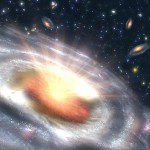
A note extracted from John Warwick Montgomery, “Miracle Evidence: How Philosophers Go Wrong,” Philosophia Christi 17/1 (2015): 199-203, followed by my own meditations on it:
“No testimony,” wrote Hume, “is sufficient to establish a miracle unless the testimony be of such a kind that its falsehood would be more miraculous than the fact which it endeavors to establish.” . . .
The Humean argument depended squarely on an eighteenth-century, absolutist view of natural law, impossible today in an Einsteinian, relativistic universe. Hume believed that our existing knowledge of the universe was sufficient to establish the cosmic unlikelihood of a miracle versus the likelihood of lying, deception, or incredible naïveté on the part of the witnesses to it. In point of fact, one cannot second-guess the universe as to what is likely or unlikely to happen; philosophers (just like the rest of us) must get off their deductivistic derrières and examine the empirical evidence for each miracle claim without prejudice for or against. That is the only way to avoid the gross circularity built into the Humean argument: miracles (obviously) will never occur if there is, as Hume asserted, “uniform experience” against the miraculous; but to assume such uniform testimony in the face of genuine miracle claims just begs the question! (200)
My observation: A great many counter-intuitive and non-commonsensical facts lie at the very base of modern science. Here are just a few items, not necessarily even the best, from a list that could go into the hundreds or thousands:
- The physical Universe that we know — planets, stars, galaxies, black holes, dust — makes up just 4 percent of whatever stuff is out there. The rest is either dark matter, at 23 percent of the Universe, or dark energy, at 73 percent.
- E=mc2
- The Earth is not at the center of the Universe
- Earth isn’t flat. It’s a globe.
- Space itself is curved.
- Light is “bent” by gravity.
- The Universe is finite but unbounded.
- Light is both particle and wave.
- The more precisely the position of a particle is determined, the less precisely its momentum can be predicted from initial conditions, and vice versa. This is the “Heisenberg uncertainty principle.”
- I grew up imagining that atoms were miniature “solar systems,” with hard little negatively-charged particles, indivisible electrons, whizzing around nuclei made up of hard little protons and neutrons. We were long past the idea that atoms were literally atomos (Greek ἄτομος, “uncut,” “indivisible”), but my very young notions were themselves already obsolete. My picture of solid subatomic particles has had to be replaced by hard-to-envision concepts like “probability waves.”
- Energy is emitted in discrete quanta, not continuously.
- Even the most solid objects are mostly empty space.
- Space and time came into existence in the Big Bang about 13.8 billion years ago
- Quantum entanglement, or “spooky action at a distance.”
- Measurements of certain systems cannot be made without affecting or changing those systems. This is the so-called “observer effect.”
And so on and so forth. Accepted, such facts have led to enormous scientific advances. Had they been rejected — and, on the basis of Hume’s principle, the reasons for at least initial rejection would seem to go far beyond ordinary cautious skepticism — we would still be living with nineteenth-century science. At the best.












